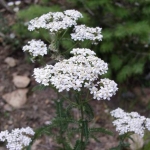| Drug Interactions: |
| Taking yarrow with these drugs may interfere with the absorption of the drug: |
| Ferric Gluconate, (Ferrlecit) |
Ferrous Fumarate, (Femiron, Feostat) |
Ferrous Gluconate, (Fergon, Novo-Ferrogluc) |
Ferrous Sulfate, (Feratab, Fer-Iron) |
| Ferrous Sulfate and Ascorbic Acid, (Fero-Grad 500, Vitelle Irospan) |
Iron-Dextran Complex, (Dexferrum, INFeD) |
Polysaccharide-Iron Complex, (Hytinic, Niferex) |
| Taking yarrow with these drugs may disrupt blood sugar control: |
| Acarbose, (Prandase, Precose) |
Glipizide, (Glucotrol) |
Glyburide, (DiaBeta, Micronase) |
| Insulin, (Humulin, Novolin R) |
Metformin, (Glucophage, Riomet) |
Miglitol, (Glyset) |
| Pioglitazone, (Actos) |
Repaglinide, (GlucoNorm, Prandin) |
Rosiglitazone, (Avandia) |
| Taking yarrow with these drugs may increase the risk of hypotension (excessively low blood pressure): |
| Acebutolol, (Novo-Acebutolol, Sectral) |
Amlodipine, (Norvasc) |
Atenolol, (Apo-Atenol, Tenormin) |
Benazepril, (Lotensin) |
Betaxolol, (Betoptic S, Kerlone) |
| Bisoprolol, (Monocor, Zebeta) |
Bumetanide, (Bumex, Burinex) |
Candesartan, (Atacand) |
Captopril, (Capoten, Novo-Captopril) |
Carteolol, (Cartrol, Ocupress) |
| Carvedilol, (Coreg) |
Chlorothiazide, (Diuril) |
Chlorthalidone, (Apo-Chlorthalidone, Thalitone) |
Clonidine, (Catapres, Duraclon) |
Diazoxide, (Hyperstat, Proglycem) |
| Diltiazem, (Cardizem, Tiazac) |
Doxazosin, (Alti-Doxazosin, Cardura) |
Enalapril, (Vasotec) |
Eplerenone, (Inspra) |
Eprosartan, (Teveten) |
| Esmolol, (Brevibloc) |
Felodipine, (Plendil, Renedil) |
Fenoldopam, (Corlopam) |
Fosinopril, (Monopril) |
Furosemide, (Apo-Furosemide, Lasix) |
| Guanabenz, (Wytensin) |
Guanadrel, (Hylorel) |
Guanfacine, (Tenex) |
Hydralazine, (Apresoline, Novo-Hylazin) |
Hydrochlorothiazide, (Apo-Hydro, Microzide) |
| Hydrochlorothiazide and Triamterene, (Dyazide, Maxzide) |
Indapamide, (Lozol, Nu-Indapamide) |
Irbesartan, (Avapro) |
Isradipine, (DynaCirc) |
Labetolol, (Normodyne, Trandate) |
| Lisinopril, (Prinivil, Zestril) |
Losartan, (Cozaar) |
Mecamylamine, (Inversine) |
Mefruside, (Baycaron) |
Methyclothiazide, (Aquatensen, Enduron) |
| Methyldopa, (Apo-Methyldopa, Nu-Medopa) |
Metolazone, (Mykrox, Zaroxolyn) |
Metoprolol, (Betaloc, Lopressor) |
Minoxidil, (Loniten, Rogaine) |
Moexipril, (Univasc) |
| Nadolol, (Apo-Nadol, Corgard) |
Nicardipine, (Cardene) |
Nifedipine, (Adalat CC, Procardia) |
Nisoldipine, (Sular) |
Nitroglycerin, (Minitran, Nitro-Dur) |
| Nitroprusside, (Nipride, Nitropress) |
Olmesartan, (Benicar) |
Oxprenolol, (Slow-Trasicor, Trasicor) |
Perindopril Erbumine, (Aceon, Coversyl) |
Phenoxybenzamine, (Dibenzyline) |
| Phentolamine, (Regitine, Rogitine) |
Pindolol, (Apo-Pindol, Novo-Pindol) |
Polythiazide, (Renese) |
Prazosin, (Minipress, Nu-Prazo) |
Propranolol, (Inderal, InnoPran XL) |
| Quinapril, (Accupril) |
Ramipril, (Altace) |
Reserpine, (Reserpine) |
Spironolactone, (Aldactone, Novo-Spiroton) |
Telmisartan, (Micardis) |
| Terazosin, (Alti-Terazosin, Hytrin) |
Timolol, (Betimol, Timoptic) |
Torsemide, (Demedex) |
Trandolapril, (Mavik) |
Triamterene, (Dyrenium) |
| Trichlormethiazide, (Metatensin, Naqua) |
Valsartan, (Diovan) |
Verapamil, (Calan, Isoptin SR) |
| Taking yarrow with these drugs may increase the risk of bleeding or bruising: |
| Abciximab, (ReoPro) |
Aminosalicylic Acid, (Nemasol Sodium, Paser) |
Antithrombin III, (Thrombate III) |
Argatroban, (Argatroban) |
| Aspirin, (Bufferin, Ecotrin) |
Aspirin and Dipyridamole, (Aggrenox) |
Bivalirudin, (Angiomax) |
Choline Magnesium trisalicylate, (Trilisate) |
| Choline Salicylate, (Teejel) |
Clopidogrel, (Plavix) |
Dalteparin, (Fragmin) |
Danaparoid, (Orgaran) |
| Dipyridamole, (Novo-Dipiradol, Persantine) |
Enoxaparin, (Lovenox) |
Eptifibatide, (Integrillin) |
Fondaparinux, (Arixtra) |
| Heparin, (Hepalean, Hep-Lock) |
Indobufen, (Ibustrin) |
Lepirudin, (Refludan) |
Salsalate, (Amgesic, Salflex) |
| Ticlopidine, (Alti-Ticlopidine, Ticlid) |
Tinzaparin, (Innohep) |
Tirofiban, (Aggrastat) |
Warfarin, (Coumadin, Jantoven) |
| Taking yarrow with these drugs may increase the risk of excessive sedation and mental depression and impairment: |
| Acetaminophen and Codeine, (Capital and Codeine, Tylenol with Codeine) |
Alfentanil, (Alfenta) |
Alprazolam, (Apo-Alpraz, Xanax) |
Amobarbital, (Amytal) |
| Amobarbital and Secobarbital, (Tuinal) |
Aspirin and Codeine, (Coryphen Codeine) |
Belladonna and Opium, (B&O Supprettes) |
Bromazepam, (Apo-Bromazepam, Gen-Bromazepam) |
| Brotizolam, (Lendorm, Sintonal) |
Buprenorphine, (Buprenex, Subutex) |
Buprenorphine and Naloxone, (Suboxone) |
Butabarbital, (Butisol Sodium) |
| Butalbital, Acetaminophen and Caffeine, (Esgic, Fioricet) |
Butalbital, Aspirin and Caffeine, (Fiorinal) |
Butorphanol, (Apo-Butorphanol, Stadol) |
Chloral Hydrate, (Aquachloral Supprettes, Somnote) |
| Chlordiazepoxide, (Apo-Chlordiazepoxide, Librium) |
Clobazam, (Alti-Clobazam, Frisium) |
Clonazepam, (Klonopin, Rivotril) |
Clorazepate, (Tranxene, T-Tab) |
| Codeine, (Codeine Contin) |
Dexmedetomidine, (Precedex) |
Diazepam, (Apo-Diazepam, Valium) |
Dihydrocodeine, Aspirin, and Caffeine, (Synalgos-DC) |
| Diphenhydramine, (Benadryl Allergy, Nytol) |
Estazolam, (ProSom) |
Fentanyl, (Actiq, Duragesic) |
Flurazepam, (Apo-Flurazepam, Dalmane) |
| Glutethimide, (Glutethimide) |
Haloperidol, (Haldol, Novo-Peridol) |
Hydrocodone and Acetaminophen, (Vicodin, Zydone) |
Hydrocodone and Aspirin, (Damason-P) |
| Hydrocodone and Ibuprofen, (Vicoprofen) |
Hydromorphone, (Dilaudid, PMS-Hydromorphone) |
Hydroxyzine, (Atarax, Vistaril) |
Levomethadyl Acetate Hydrochloride, (Levomethadyl Acetate Hydrochloride) |
| Levorphanol, (LevoDromoran) |
Loprazolam, (Domonoct, Havlane) |
Lorazepam, (Ativan, Nu-Loraz) |
Meperidine, (Demerol, Meperitab) |
| Meperidine and Promethazine, (Meperidine and Promethazine) |
Mephobarbital, (Mebaral) |
Methadone, (Dolophine, Methadose) |
Methohexital, (Brevital, Brevital Sodium) |
| Midazolam, (Apo-Midazolam, Versed) |
Morphine Sulfate, (Kadian, MS Contin) |
Nalbuphine, (Nubain) |
Opium Tincture, (Opium Tincture) |
| Oxycodone, (OxyContin, Roxicodone) |
Oxycodone and Acetaminophen, (Endocet, Percocet) |
Oxycodone and Aspirin, (Endodan, Percodan) |
Oxymorphone, (Numorphan) |
| Paregoric, (Paregoric) |
Pentazocine, (Talwin) |
Pentobarbital, (Nembutal) |
Phenobarbital, (Luminal Sodium, PMS-Phenobarbital) |
| Phenoperidine, (Phenoperidine) |
Prazepam, (Prazepam) |
Primidone, (Apo-Primidone, Mysoline) |
Promethazine, (Phenergan) |
| Propofol, (Diprivan) |
Propoxyphene, (Darvon, Darvon-N) |
Propoxyphene and Acetaminophen, (Darvocet-N 50, Darvocet-N 100) |
Propoxyphene, Aspirin, and Caffeine, (Darvon Compound) |
| Quazepam, (Doral) |
Remifentanil, (Ultiva) |
Secobarbital, (Seconal) |
Sufentanil, (Sufenta) |
| S-Zopiclone, (Lunesta) |
Temazepam, (Novo-Temazepam, Restoril) |
Tetrazepam, (Mobiforton, Musapam) |
Thiopental, (Pentothal) |
| Triazolam, (Apo-Triazo, Halcion) |
Zaleplon, (Sonata, Stamoc) |
Zolpidem, (Ambien) |
Zopiclone, (Alti-Zopiclone, Gen-Zopiclone) |
| Taking yarrow with this drug may be harmful: |
| Sucralfate, (Carafate, Sulcrate)—May interfere with the action of the drug. |
|
